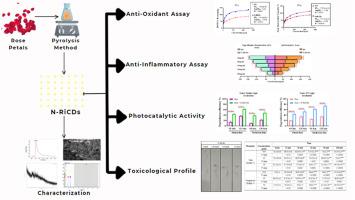Biofunctional and ecotoxicological assessment of Rosa indica derived nitrogen-doped Carbon Dots: A new frontier for sustainable nanomaterials
IF 3.8
Q2 BIOTECHNOLOGY & APPLIED MICROBIOLOGY
引用次数: 0
Abstract
Carbon Dots (CDs) have emerged as a promising material for a variety of therapeutic applications. Nitrogen doped Rosa indica (R. indica) fluorescent Carbon dots (N-RiCDs) were prepared by the utilization of pyrolysis method. Ultraviolet–visible, fourier transform infrared spectroscopy, X-ray diffraction, scanning microscope, energy-dispersive X-ray spectroscopy and raman spectroscopy revealed the optical and structural characteristics of the synthesized N-RiCDs. In vitro anti-oxidant assessment including free radical scavenging activity (DPPH assay) and phosphomolybdate assay showed EC50 value of 45.28 μg/mL and 111.7 μg/mL respectively. In vitro anti-inflammatory assessment was performed by the utilization of egg albumin denaturation (EA) assay and anti-hemolytic assay. An EC50 value of 36.05 μg/mL and 27.64 μg/mL was reported for protein denaturation and hemolysis protection capability respectively. Both anti-oxidant and anti-inflammatory activities were significantly increased in a dose-dependent manner. The photocatalytic dye degradation efficiency was observed higher (43.33 %–53 %) for phenol red under visible light irradiation while methylene blue degradation efficiency was observed higher (62.33 %–74.33 %) under UV irradiation. Toxicological profiling showed promising results including phytotoxicity and in vitro sperm motility assessment with significant minimal adverse effects. Low cytotoxicity was observed toward HepG2 cancer cells. In vivo studies revealed the mild acute toxicity in broiler chickens up to 10 mg/kg of N-RiCDs. This study proved that under controlled conditions, the N-RiCDs can be further scrutinized for potential clinical and environmental implementations.

玫瑰衍生的氮掺杂碳点的生物功能和生态毒理学评价:可持续纳米材料的新前沿
碳点(cd)已成为一种有前途的材料,用于各种治疗应用。利用热解法制备了氮掺杂玫瑰荧光碳点(N-RiCDs)。紫外可见光谱、傅里叶变换红外光谱、x射线衍射、扫描显微镜、能量色散x射线光谱和拉曼光谱揭示了合成的N-RiCDs的光学和结构特征。体外抗氧化评价包括自由基清除能力(DPPH)和磷酸钼酸盐测定的EC50值分别为45.28 μg/mL和111.7 μg/mL。采用鸡蛋白蛋白变性(EA)试验和抗溶血试验进行体外抗炎评价。蛋白变性和溶血保护的EC50值分别为36.05 μg/mL和27.64 μg/mL。抗氧化和抗炎活性均以剂量依赖性方式显著增加。光催化染料在可见光照射下对苯酚红的降解效率较高(43.33% ~ 53%),而在紫外照射下对亚甲基蓝的降解效率较高(62.33% ~ 74.33%)。毒理学分析显示了有希望的结果,包括植物毒性和体外精子活力评估,副作用极小。对HepG2癌细胞具有较低的细胞毒性。体内研究表明,N-RiCDs对肉鸡的轻度急性毒性可达10 mg/kg。这项研究证明,在受控条件下,n - ricd可以进一步审查潜在的临床和环境应用。
本文章由计算机程序翻译,如有差异,请以英文原文为准。
求助全文
约1分钟内获得全文
求助全文
来源期刊

Biocatalysis and agricultural biotechnology
Agricultural and Biological Sciences-Agronomy and Crop Science
CiteScore
7.70
自引率
2.50%
发文量
308
审稿时长
48 days
期刊介绍:
Biocatalysis and Agricultural Biotechnology is the official journal of the International Society of Biocatalysis and Agricultural Biotechnology (ISBAB). The journal publishes high quality articles especially in the science and technology of biocatalysis, bioprocesses, agricultural biotechnology, biomedical biotechnology, and, if appropriate, from other related areas of biotechnology. The journal will publish peer-reviewed basic and applied research papers, authoritative reviews, and feature articles. The scope of the journal encompasses the research, industrial, and commercial aspects of biotechnology, including the areas of: biocatalysis; bioprocesses; food and agriculture; genetic engineering; molecular biology; healthcare and pharmaceuticals; biofuels; genomics; nanotechnology; environment and biodiversity; and bioremediation.
 求助内容:
求助内容: 应助结果提醒方式:
应助结果提醒方式:


